Taken: Oregonians Arrested after Pearl Harbor
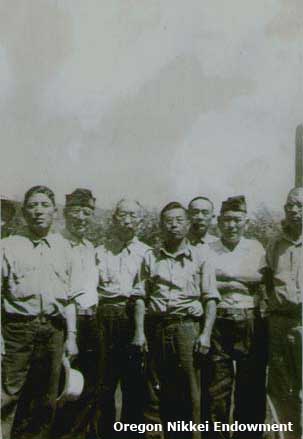
|
||
| Licensing | ||
This album illustrates the experiences of families in Oregon taken into custody and imprisoned by the Federal Bureau of Investigation (FBI) and Department of Justice (DoJ) as a result of the bombing of the U.S. naval base at Pearl Harbor, Hawaii, by Imperial Japanese fighter planes on December 7, 1941. In this lesser known prelude to Executive Order 9066, which led to the internment of Japanese Americans for the duration of World War II, prominent members of the Japanese American community — mostly men — were rounded up by FBI agents just hours after the bombing. Shackled and whisked away, often after dark with no explanation offered them or their stunned and bewildered families, they were then sent to "special" camps in remote, secret sites across the United States, different from the ones their families would begin to occupy in the summer of 1942. Based on the exhibit Taken: FBI , curated by the Oregon Nikkei Endowment.
Slides in this album |
|
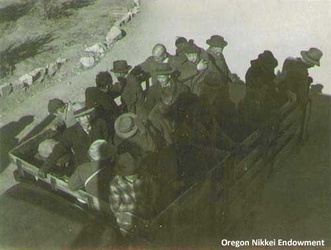
|
How Was This Possible?"My father was taken just after December 7th. Officials entered our house, searched everything and took him away." Who were these individuals who were taken? How was the FBI able to target them so quickly after the surprise attack? How was this possible in a nation founded by and built … |
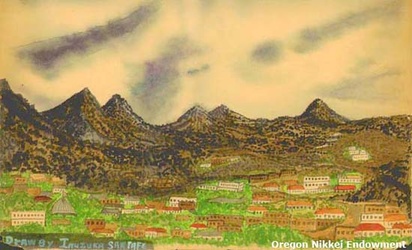
|
How was this possible?Although prominent in the Japanese community, those "taken," as we are calling them, lived in the shadow of restrictive laws, including anti-miscegenation laws and the Japanese Exclusion Act of 1924. Asian nationals and other immigrants from around the world looked to the U.S. as the land of opportunity, with the … |

|
How Was This Possible?: Dr. Benjamin TanakaBenjamin Tanaka was born on a plantation in Hawaii where his immigrant parents worked in the pineapple and sugarcane fields. By age 12, determined to pursue an education, he stowed away on a boat to the mainland and ended up in Idaho to continue his schooling. As a teenager, he … |
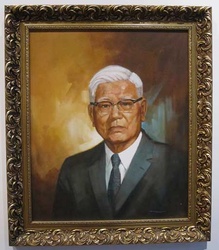
|
How Was This Possible?: Dr. Benjamin TanakaWhen Gus Tanaka was asked why his father was arrested, he answered readily: He was one of the very few people of his generation who had an education above high school in this country. You know, he never lost his Hawaiian accent. Nevertheless, he was able to counsel … |

|
How Was This Possible?: Masuo YasuiMasuo Yasui was born in 1886 and moved to Hood River in 1908, where he and his brother opened a small store to serve the hundreds of immigrant Japanese laborers working in the nearby logging camps, sawmills, and orchards. Over time the Yasui Brothers' store became a very successful business … |

|
How Was This Possible?: Masuo YasuiThe INS hearing board member produced drawings made by Masuo’s children, showing how the locks of the Panama Canal worked: Then the officer asked my father to explain why they were in our home. "If they were in my home," my father replied, "it seems to me that … |
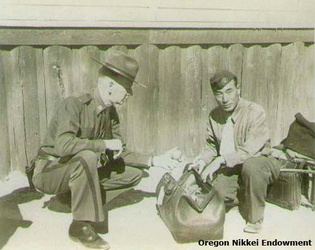
|
How were they selected?The motivation for action under the Alien Enemies Act of 1798 and Executive Order 9066 starts from the early 1900s with the rise of racial and ethnic anti-Japanese prejudices in the western United States. By the 1930s, the United States was growing increasingly apprehensive about its probable involvement in the … |
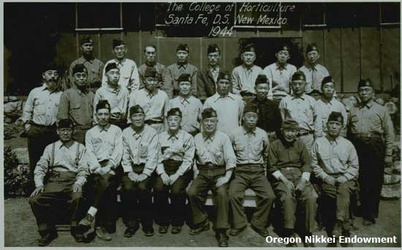
|
How Were They Selected?The "A-B-C" Custodial Detention List The names compiled by the FBI, DoJ, and ONI were evaluated according to the degree of their possible danger "to the peace and security" of the United States. The ONI and the Special Defense Unit of DoJ created an "A-B-C" classification system to rank these … |

|
How were they selected?: Daiichi TakeokaOne of Portland's early Japanese immigrants, Daiichi Takeoka emigrated from Hiroshima in 1900 at the age of 18. From a farming family and with a mid-grammar school education, he worked on the Seattle, Portland & Spokane Railroad, in the timber industry, and at the Portland Hotel as a bellhop. Daiichi earned …
Daiichi Takeoka in his office ca. 1910-1915, Portland, Oregon |

|
How were they selected?: Daiichi Takeoka
Daiichi Takeoka recieved this commerative silver tray from the Portland Japanese Association in 1938. Membership in organizations like this meant an individual would likely be included in the A-B-C list and arrested. Daiichi Takeoka's son, Tom, was asked why he thought his father was arrested: I feel …
Commerative Silver Tray from the Portland Japanese Association to Daiichi Takeoka |

|
How Were They Selected?: Takashi InuzukaTakashi Inuzuka came from Chiba, Japan, in 1903. He and his wife eventually purchased a greenhouse in Southeast Portland and began the "Nippon Florists." Involved with numerous Japanese community groups and an active participant with the Japanese Chamber of Commerce, the Japanese government awarded him a "paulownia cup" (lacquered bowl … |
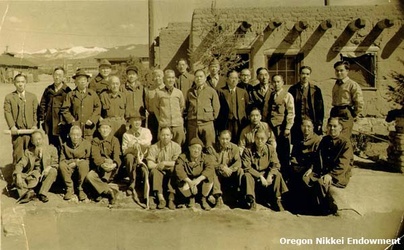
|
The Authority for the ArrestsThe United States' overt imprisonment of people of Japanese ancestry began during the bombing of Pearl Harbor. On December 7, 1941, even while the Imperial Japanese air attack was in progress, agents of the U.S. military, the FBI, the Justice Department, and local law enforcement officers fanned out across the … |

|
The Authority for the ArrestsThe Alien Enemies Act (AEA) and Executive Order (EO) 9066 differed in their scope and in the treatment of those affected. The AEA becomes operational upon declaration of war and a public proclamation by the President that, "natives, citizens, or subjects of the hostile nation" could be "apprehended, restrained, secured, … |

|
The Authority for the Arrests: Umata MatsushimaUmata Matsushima ran his adoptive father's dry goods store, Teikoku Company, located in Portland's Japantown. When Pearl Harbor was attacked, the store was shut down, its business license suspended, and a marshal posted outside the door. Umata Matsushima was arrested. Umata was not only a very successful businessman but had … |

|
The Authority for the Arrests: Sadaji "Hood" ShiogiBorn in the Japanese Alps, Sadaji Shiogi came to America and purchased ten acres of farmland just east of Portland in Montavilla, growing produce that they took by wagon to the early morning Italian market in Portland. During World War I, Sadaji Shiogi leased a thousand acres in Troutdale to … |
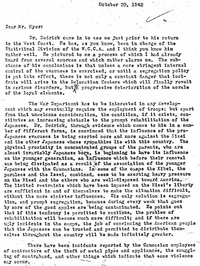
|
What Lessons Have Been Learned?There are Arab Americans today who are going through what Japanese Americans experienced years ago, and we can’t let that happen again. I met someone years ago who had never heard of the roundup of Japanese Americans. It’s been sixty years since this [arrest] happened, and it’s happening again, and …
A letter from John J. McCloy to Dillon S. Myer (part 1) |
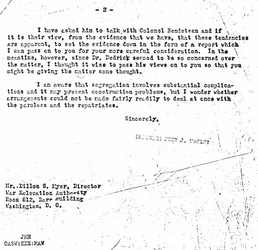
|
What Lessons Have Been Learned?The events surrounding the attacks of September 11, 2001, and the subsequent treatment of Arab Americans paralleled that of Japanese Americans 60 years prior. As Lorraine Bannai, part of the legal team in Korematsu v. United States and Associate Director of the Fred T. Korematsu Center for Law and Equality …
A letter from John J. McCloy to Dillon S. Myer (part 2) |

|
What Lessons Have Been Learned?: Tora MiyakeIn the wake of the attack on Pearl Harbor, a handful of women were taken in and released, but only one woman was imprisoned—Tora Miyake. Her husband had died in 1936, so she eked out a living by teaching piano, teaching part-time at a Japanese language school and working as … |
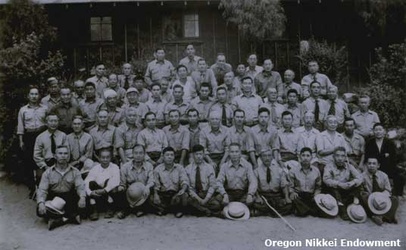
|
What Lessons Have Been Learned?: Rev. Shigeo OkazakiShigeo Okazaki arrived Portland in 1915 at age 29. With a truck, he operated a delivery service that picked up and delivered luggage or imports from Japan. Shigeo later returned to Japan to train to become the leader of the Tenrikyo Church in Portland. Rev. Okazaki's son John recalls: |
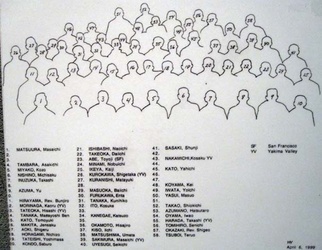
|
Who was "taken?"Each person arrested and taken from Oregon has a unique story. The stories told here have been selected from a few individuals to show the variety of backgrounds that might have made them targets for arrest, and the impact their imprisonment had on their lives and families. Sources cited: Lorraine …
Oregon Inmates held at Santa Fe, NM (name key) |
 Oregon_Nikkei
Oregon_Nikkei
 Taken: Oregonians Arrested after Pearl Harbor
Taken: Oregonians Arrested after Pearl Harbor Nikkei Farmers of the Hood River Area
Nikkei Farmers of the Hood River Area Nihonmachi: Portland's Japantown
Nihonmachi: Portland's Japantown
 Journal feed
Journal feed
